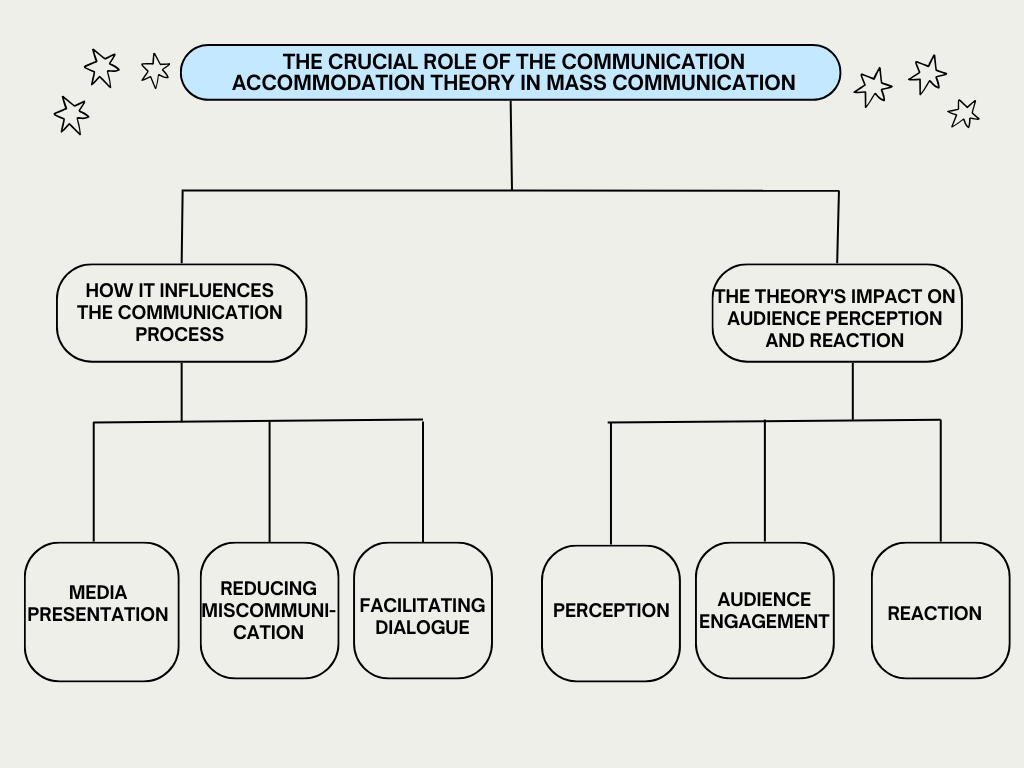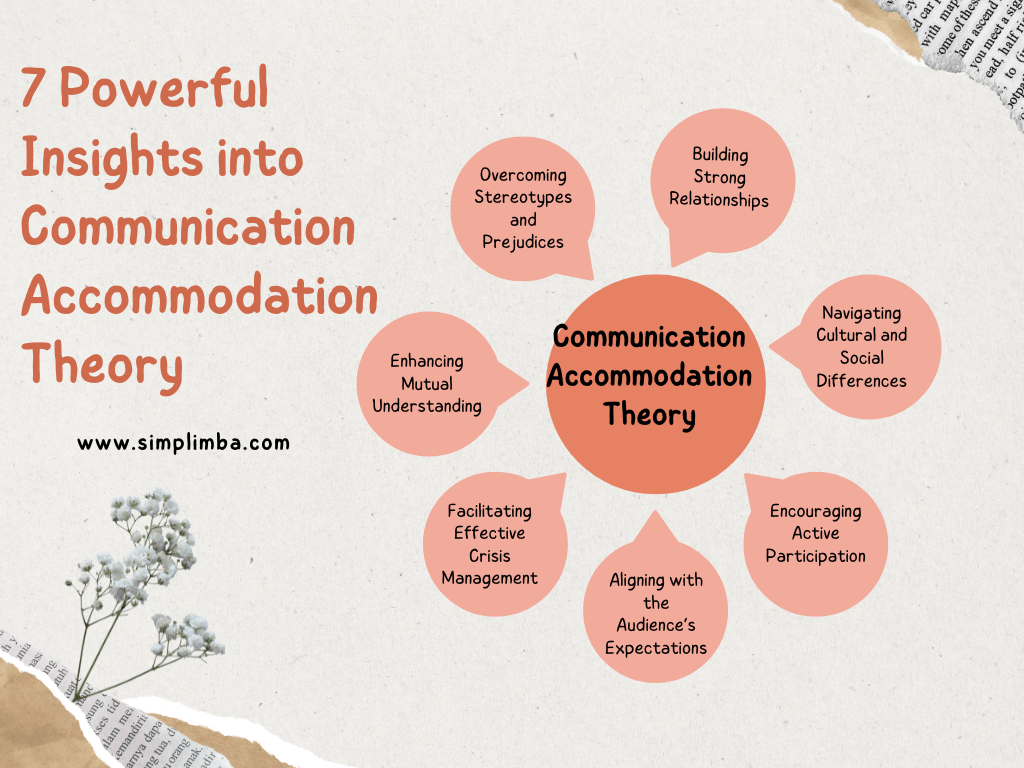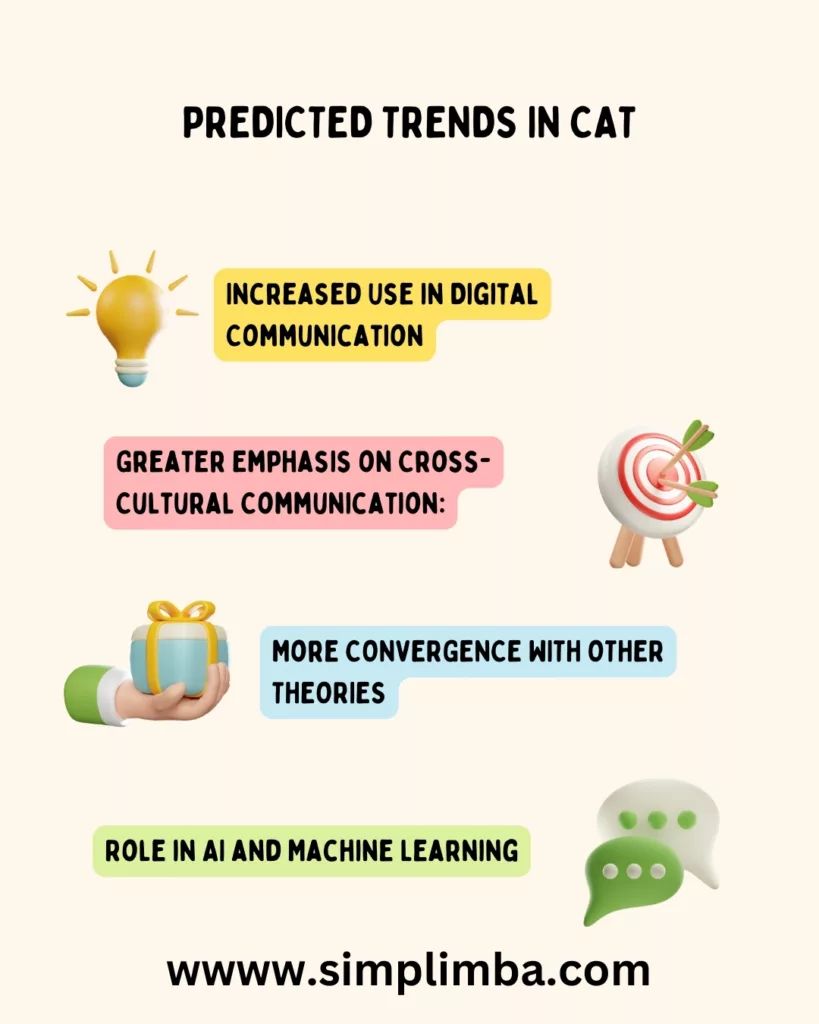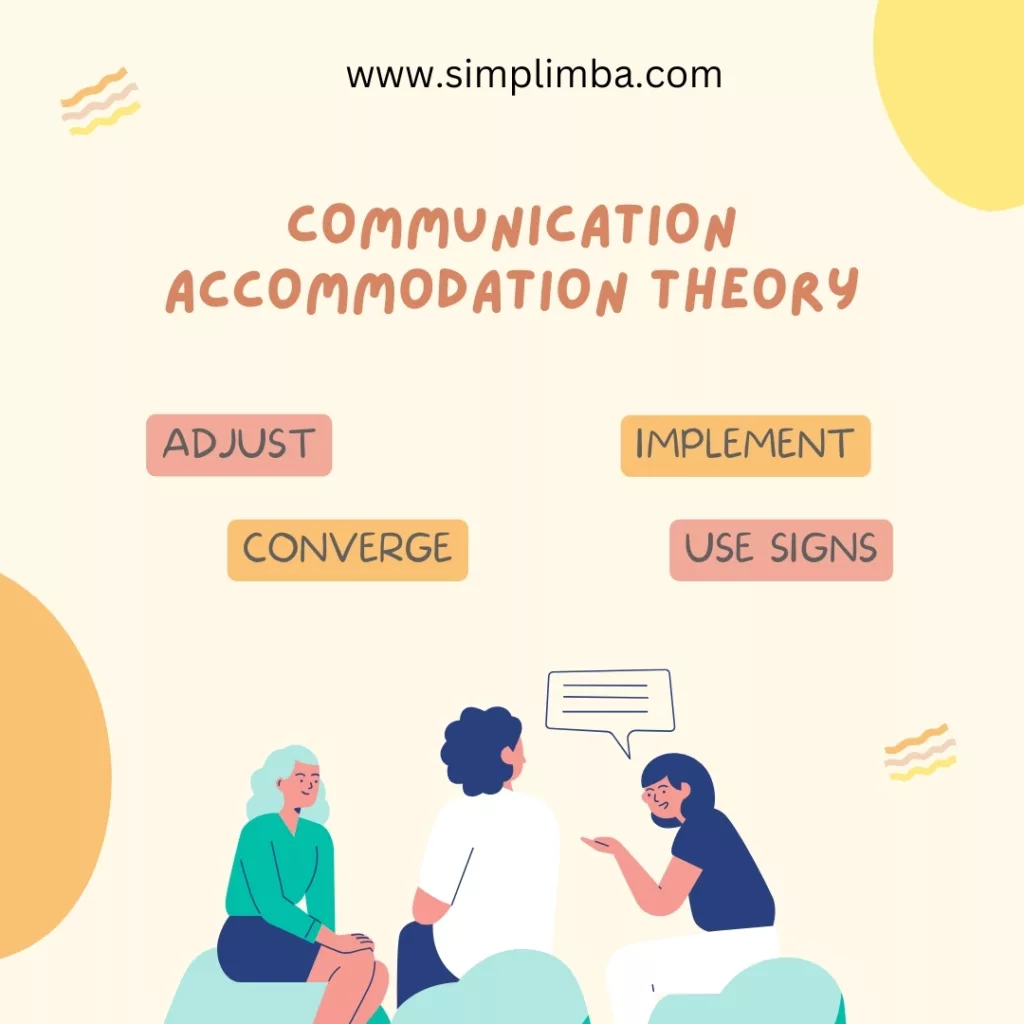Definition of Communication Accommodation Theory
Communication Accommodation Theory (CAT), first proposed by Howard Giles in 1973, refers to the behavioral changes individuals make to either accentuate or minimize their social differences. These alterations are often subconscious and reflect the speaker’s inclination to either converge or diverge from the styles of the person they’re communicating with.
Convergence occurs when an individual adapts their communication style to match that of the person they’re interacting with, often to gain social approval or empathize. Divergence, on the contrary, happens when someone emphasizes the differences between themselves and others, usually to maintain a distinct identity or to denote superiority.
Brief Background of its Application in Mass Communication
The application of CAT in mass communication is deeply entrenched and has gathered increased relevance with digital media’s rise. In mass communication, such as news broadcasting or advertising, the speaker or communicator converges to the audience’s style, interests, and expectations to ensure maximum engagement and understanding.
For example, a news broadcaster may choose to use simpler language when reporting on complicated topics to make the news more digestible for the general public. Similarly, in advertising, an ad campaign will likely use language, symbols, and cultural references that resonate with their target demographic.
Television shows and streaming platforms also often use CAT to create relatable content. They try to mirror the audience’s experiences and perspectives, leading to higher engagement and viewer ratings.
In contrast, divergence in mass communication is less common but can be strategically used to create a unique identity or to stand out from competitors. For example, a news channel might focus on investigative journalism, diverging from the mainstream news outlets that focus more on breaking news or sensational stories.
While CAT provides a useful framework for understanding and predicting communication behavior, it is not a mathematical or scientific law. It does not account for all variables and factors in communication, like individual personalities or cultural nuances, which might impact how individuals accommodate their communication.
The Evolution of Communication Accommodation Theory
Originating in the early 1970s, the Communication Accommodation Theory (CAT) was first introduced by social psychologists Howard Giles and Philip Powesland. The theory was initially designed as the ‘Speech Accommodation Theory’ with the broad objective of understanding why people modify their communication styles during interpersonal interactions.
The birth of CAT occurred against a backdrop of social movements and cultural shifts, fueled by the Civil Rights Movement, the Feminist Movement, and the Gay Rights Movement. These social changes spurred academic interest in understanding social identity, cultural assimilation, and intergroup dynamics, which eventually paved the way for the CAT.
Progression and Changes Over Time
Over the decades, the Communication Accommodation Theory has undergone significant evolution, expanding beyond the original scope of speech and language to include nonverbal communication, such as gestures, body language, and other non-linguistic cues.
1970s-1980s: In its early stages, CAT primarily focused on understanding how individuals adjust their speech patterns and language to accommodate or resist social norms and identity groups.
1990s: This decade marked a paradigm shift in CAT’s development where the theory extended its reach to include nonverbal communication. This shift was influenced by advances in communication and psychology research that recognized the significance of nonverbal cues in interpersonal communication.
2000s-Present: In the modern digital age, CAT continues to evolve, now considering how accommodation takes place in online and digital communications. With the widespread use of social media, email, text messaging, and other digital platforms, scholars have started to explore how CAT applies to these new forms of communication.
The 4 Core Concepts of Communication Accommodation Theory in Mass Communication

Convergence
Convergence in the Communication Accommodation Theory refers to the process in which individuals alter their speech patterns to more closely resemble the speech of the individual they are speaking to. This can include changes in accent, rate of speech, vocabulary use, and even non-verbal cues. The goal of convergence is often to increase social approval and rapport by reducing socio-cultural differences, thereby facilitating more effective communication.
This phenomenon is commonly observed in mass communication, where broadcasters, journalists or advertisers often adjust their communication style to appeal to their target audience. For example, a radio host might adopt more colloquial language when speaking to a younger audience.
Divergence
On the other hand, divergence refers to the act of accentuating the speech and non-verbal differences between oneself and the other person to emphasize a unique group identity or to create social distance. This can be a conscious choice or an unconscious reaction to perceived social divisions.
In mass communication, divergence can be used strategically to appeal to specific demographics or reinforce group identity. For example, a regional news outlet might maintain a local accent or dialect in their broadcasts to differentiate themselves from national news outlets and appeal to their local viewers.
Over-accommodation
Over-accommodation occurs when a speaker unnecessarily overdoes convergence or divergence. For example, adopting an exaggerated accent or using excessively formal language can be seen as over-accommodation. This can often lead to negative effects, such as making the other party feel patronized or stereotyped.
In mass communication, over-accommodation can backfire and lead to audience alienation. For example, if a TV presenter excessively uses youth slang when speaking to a younger audience, it could come off as inauthentic and patronizing.
Under-accommodation
Under-accommodation, on the other hand, refers to a lack of effort in adjusting one’s communication style. This can be perceived as indifference or disrespect, and can result in communication barriers.
In a mass communication context, under-accommodation could occur when a communicator fails to consider the cultural, linguistic, or demographic background of their audience. For example, using technical jargon in a news report intended for a general audience would be an instance of under-accommodation.
The Crucial Role of the Communication Accommodation Theory in Mass Communication

How it Influences the Communication Process
The Communication Accommodation Theory, originally proposed by sociolinguist Howard Giles in 1973, posits that during communication, people tend to adjust their speech, vocal patterns, and gestures to accommodate others. In the realm of mass communication, this theory plays a significant role in shaping the way information is disseminated to the public.
Media Presentation: The way media outlets present information is heavily influenced by CAT. For instance, in news reporting, journalists often modify their language or tone to match the audience’s linguistic style. This accommodation can make the news more relatable and easy to comprehend, thereby ensuring effective communication.
Reducing Miscommunication: Miscommunication or misunderstanding can occur when there’s a mismatch between the sender’s message and the receiver’s interpretation. CAT helps to minimize this discrepancy by encouraging communicators to adjust their language, tone, and non-verbal cues to match the audience’s needs and preferences, resulting in clearer, more effective communication.
Facilitating Dialogue: By accommodating the audience’s communication style, media can facilitate a more inclusive dialogue. This can foster a sense of belonging among diverse audience groups and promote positive social change.
The Theory’s Impact on Audience Perception and Reaction
The Communication Accommodation Theory not only influences how messages are conveyed, but also how they’re received and interpreted by the audience.
Perception: According to CAT, audience perception can be greatly influenced by how well communicators accommodate their communication style. For instance, if a news anchor uses language or expressions familiar to the audience, they’re likely to perceive the news as more credible and trustworthy.
Audience Engagement: CAT can significantly impact audience engagement. Greater accommodation can lead to increased audience participation, feedback, and engagement. For instance, a recent study published in the Journal of Communication (2019) found that TV shows that accommodated viewers’ linguistic and cultural preferences saw an 18% increase in viewer engagement.
Reaction: The audience’s reaction to a message can also be influenced by CAT. If people feel that their linguistic and cultural needs are being catered to, they may respond more positively to the message. Conversely, lack of accommodation can lead to negative reactions, such as disbelief or disregard for the information provided.
7 Powerful Insights into Communication Accommodation Theory

Enhancing Mutual Understanding
Communication Accommodation Theory (CAT) proposes that individuals adjust their communication style to promote understanding, often matching the language, speed, and tone of their conversation partner. This can be seen in everyday conversations when people mimic each other’s accents or speech patterns, either subconsciously or consciously. This synchronization of communication styles can lead to increased empathy and mutual understanding.
Overcoming Stereotypes and Prejudices
CAT can also guide us in overcoming biases and prejudices by challenging stereotypes. When people consciously adapt their communication style to be more like those of a different social group, they may find their previously held stereotypes about that group being challenged. This can pave the way for more diverse and inclusive conversations and communities.
Building Strong Relationships
CAT suggests that communication style adaptation is a key factor in building strong interpersonal relationships. By accommodating each other’s communication styles, individuals can enhance their social bonds, reduce misunderstandings, and increase their likability. This principle can be applied in various types of relationships, such as friendships, romantic relationships, and professional relationships.
In a globalized world, CAT becomes even more critical in managing cultural and social differences. Adapting communication styles to the cultural norms and expectations of conversation partners can lead to better cross-cultural understanding and collaboration. It can help in mitigating potential conflicts arising from cultural misunderstandings.
Encouraging Active Participation
According to CAT, people are more likely to engage and participate actively in conversations when they feel their communication styles are being respected and accommodated. This can be particularly beneficial in group discussions, team collaborations, and community engagements, leading to more inclusive and productive results.
Aligning with the Audience’s Expectations
In public speaking or media communication, aligning with the audience’s communication expectations is crucial for effective message delivery. CAT can guide speakers in understanding and adapting to their audience’s language use, cultural norms, and communication expectations, thereby increasing the effectiveness and impact of their messages.
Facilitating Effective Crisis Management
In crisis situations, effective communication is paramount. CAT can provide guidelines on how to best communicate in such situations, such as adopting a calm and reassuring tone, using clear and simple language, and demonstrating empathy for those affected. This can help reduce panic and confusion, provide clear instructions, and foster a sense of unity and shared purpose.
Case Studies of Communication Accommodation Theory in Action
Case Study 1: News Media
Communication Accommodation Theory (CAT) is a prominent theory in the field of communication that explores the psychological and contextual motivations and consequences of what happens when two speakers adjust their communication styles. News media is an excellent case study of CAT at work, due to its diverse audience and the need to communicate effectively.
Linguistic Styles: News outlets often adjust their linguistic style to suit their target audience. A tabloid newspaper such as ‘The Sun’ uses simpler language and more sensational headlines to appeal to a mass audience, while ‘The Times’ uses more complex language and sober headlines to cater to a more educated demographic. Both are examples of convergence in CAT, where speakers adjust their style to match the listener’s.
Speech Speed and Tone: News anchors also modulate their speech speed, tone, and volume depending on the nature of the news. Breaking news or emergency updates are often delivered at a faster pace and higher volume to convey urgency, displaying divergence in CAT where communicative behavior is adjusted to signal a difference in social identity or status.
Non-Verbal Cues: Non-verbal cues such as facial expressions, hand gestures, and body language are also a key component of communication in news media. These are often adjusted to match the tone and content of the news being delivered.
Case Study 2: Social Media
Social media platforms have revolutionized communication, and provide a fertile ground for observing CAT in action.
Texting Lingo: The use of abbreviations, emojis, and slang are widespread on social media platforms as users converge their text style to fit into particular online communities.
Personal vs. Professional Use: Many users maintain different social media accounts for personal and professional use, often adjusting their communication styles between the two. Personal accounts might see a more casual tone, use of slang, and informal language (convergence), while professional accounts might use more formal language, industry-specific jargon, and a more serious tone (divergence).
Brand Communication: Brands on social media often adjust their communication to match their target audience – a brand targeting teenagers might use more emojis, slang, and casual language, while a luxury brand might use sophisticated language and high-quality visuals.
Case Study 3: Advertising
Advertising is another realm where CAT is widely employed to influence consumer behavior.
Language and Jargon: Advertisers often use language and jargon that their target audience will understand and find appealing. For example, tech companies often use industry-specific jargon in their ads to appeal to tech-savvy consumers.
Celebrity Endorsements: Advertisers also use celebrity endorsements as a way of converging with their target audience. By using a celebrity that the target audience admires, advertisers can create a sense of commonality and familiarity.
Cultural Sensitivity: Advertisers often adjust their ads to suit the cultural sensitivities of their target market. This can include using language, visuals, and themes that are familiar to that culture, highlighting another aspect of convergence in CAT.
The Future of Communication Accommodation Theory in Mass Communication

Predicted Trends
Increased Use in Digital Communication: As digital communication continues to rise, it’s predicted that the Communication Accommodation Theory (CAT) will play an even more significant role in understanding how communication adapts and varies in these new mediums. According to a report by We Are Social and Hootsuite, more than 4.5 billion people globally use the internet, with 3.8 billion of them active social media users. As the digital population continues to grow, so will the need for effective, accommodating communication.
Greater Emphasis on Cross-Cultural Communication: As our world becomes more globally interconnected, the role of CAT in facilitating successful cross-cultural communication is expected to grow. The rise of multinational corporations, international collaborations, and worldwide social networks necessitates better understanding and application of communication theories like CAT.
Role in AI and Machine Learning: Technological advancements in artificial intelligence (AI) and machine learning may use CAT to improve human-computer interactions. According to a report by Gartner, by 2025, customer service will be largely handled by AI and machine learning algorithms. Using CAT, these systems can be trained to better adapt to user’s communication styles, improving their overall effectiveness.
The Promise and Potential Challenges
Enhancing Communication Skills: CAT offers promising outcomes in terms of enhancing communication skills. It can help individuals and businesses strategize their communication approach, ensuring their message is effectively understood, thus increasing the chances of successful interactions.
Addressing Miscommunication: Miscommunication is a common issue in both personal and professional spheres. Effective use of CAT could mitigate these issues by emphasizing the need for communicative adaptability and responsiveness.
Potential Challenges: Despite the promising aspects, potential challenges lie in the effective implementation of CAT. Cultural differences, language barriers, and personal biases can all interfere with the theory’s application. Additionally, while digital communication opens up new avenues for CAT, it also presents unique challenges, such as the lack of non-verbal cues.
Ethical Concerns: As with any communication theory, there are ethical considerations to keep in mind. For example, while accommodation can facilitate understanding, it can also be used to manipulate or deceive. Thus, ethical use of CAT is essential.
Samrat is a Delhi-based MBA from the Indian Institute of Management. He is a Strategy, AI, and Marketing Enthusiast and passionately writes about core and emerging topics in Management studies. Reach out to his LinkedIn for a discussion or follow his Quora Page

